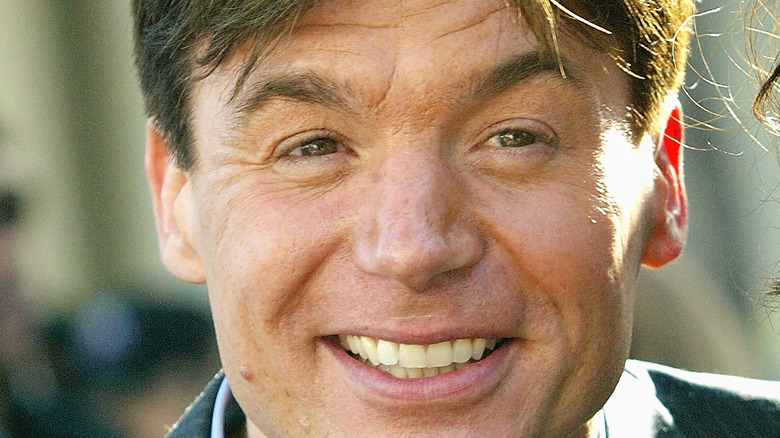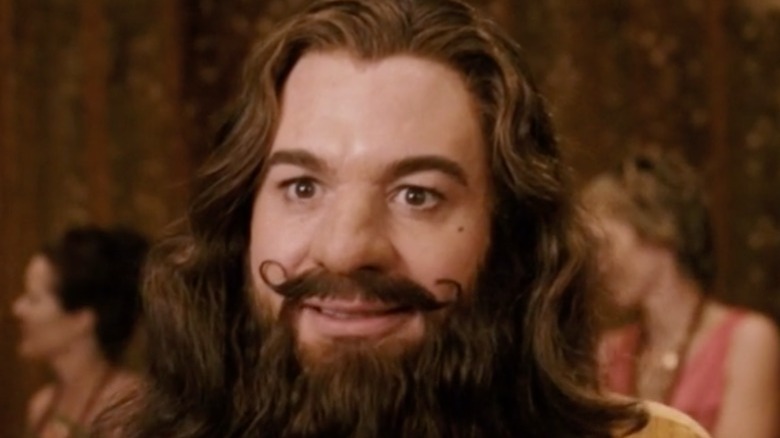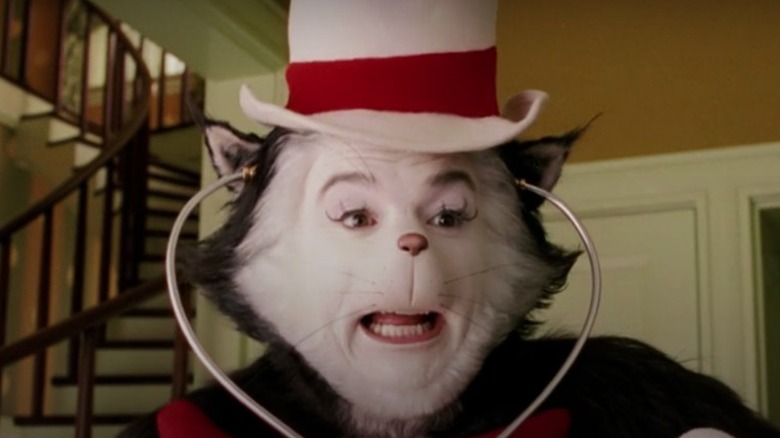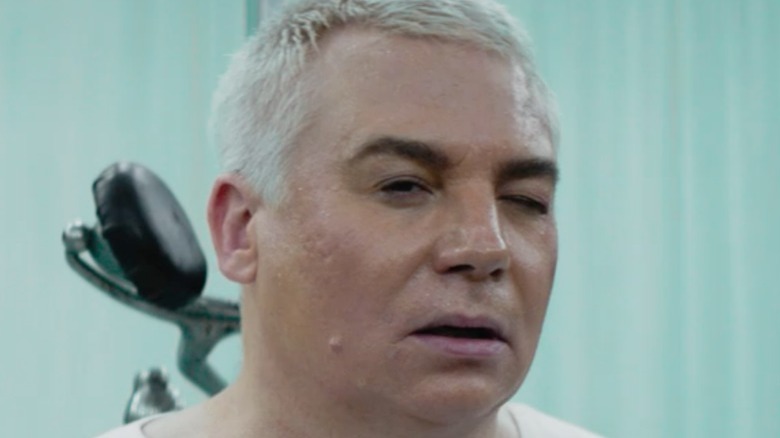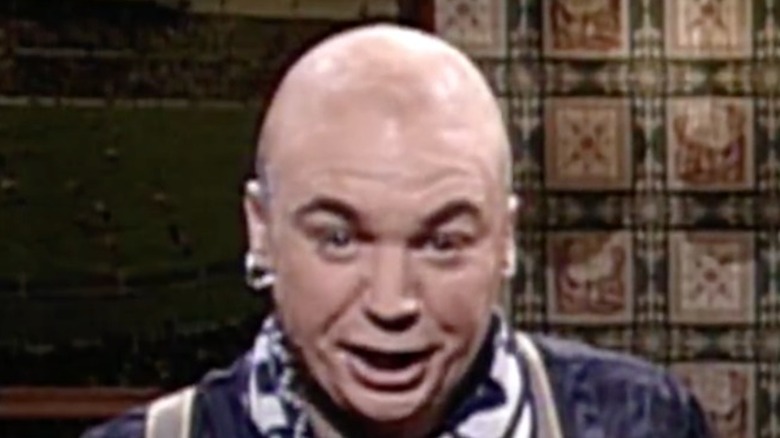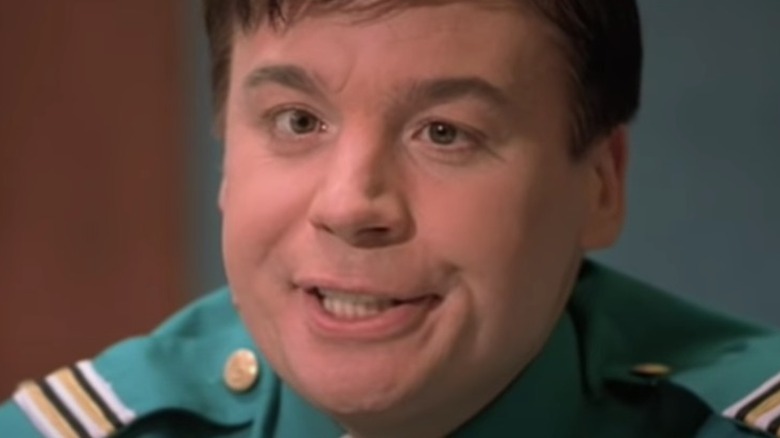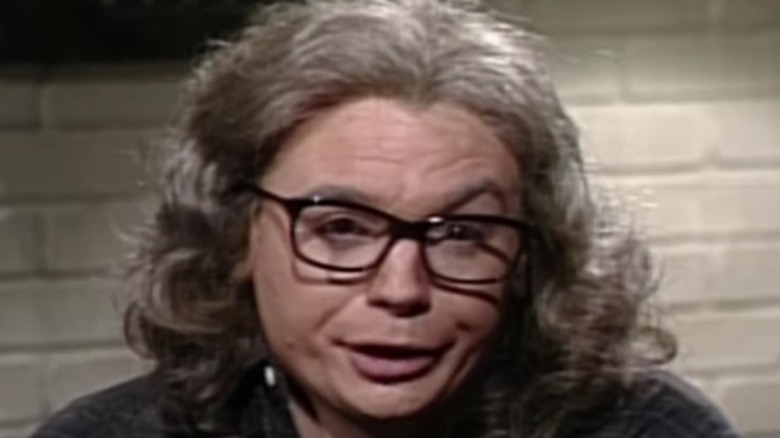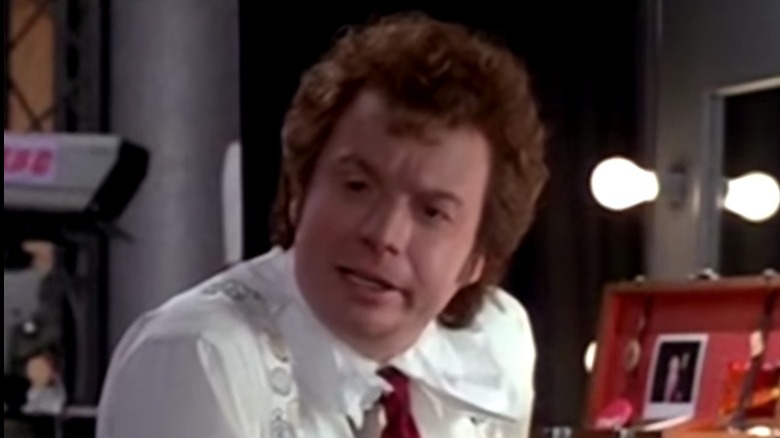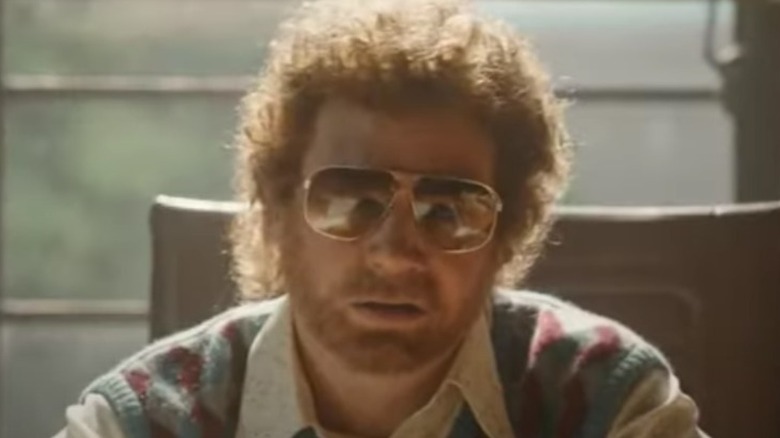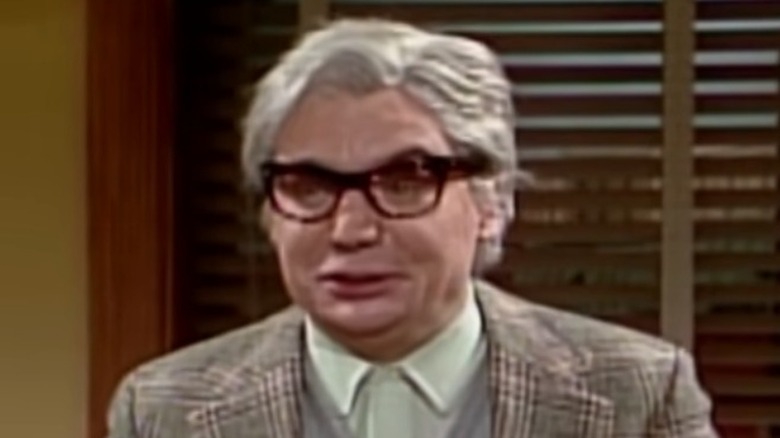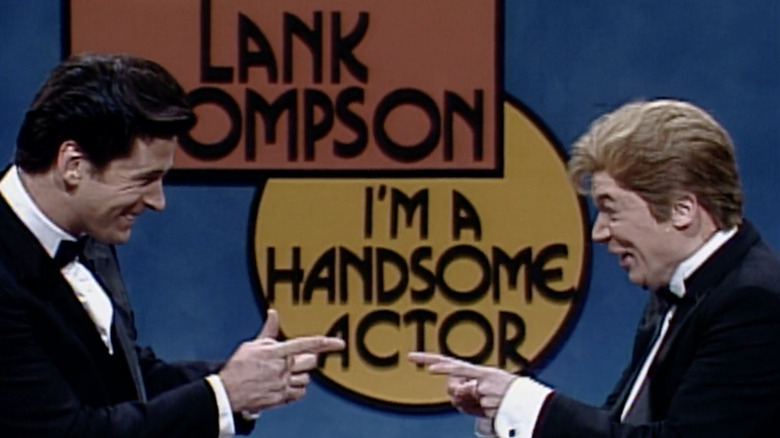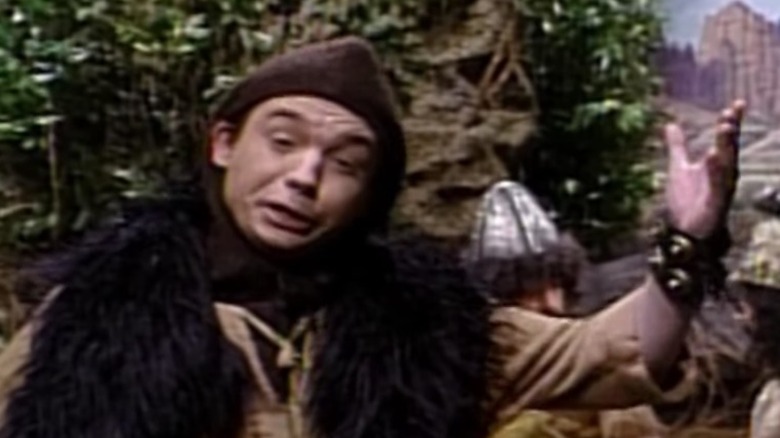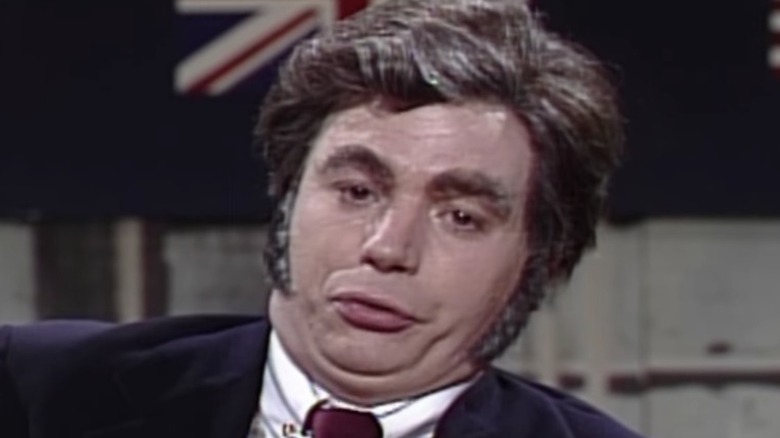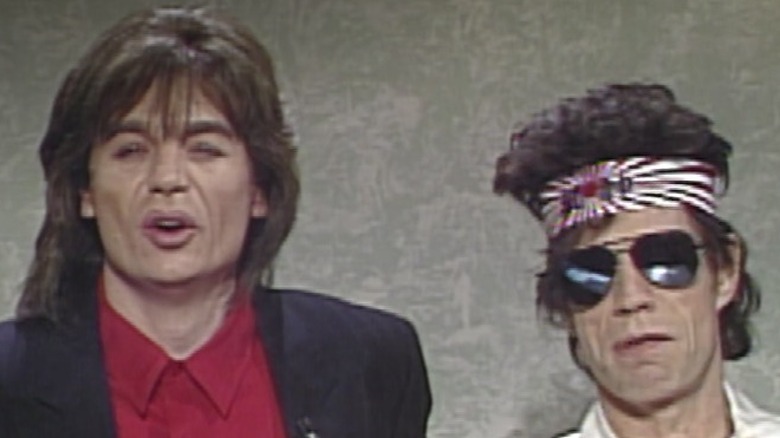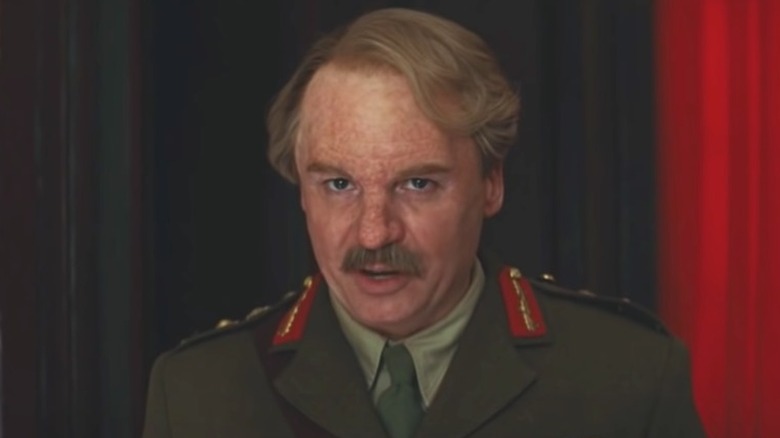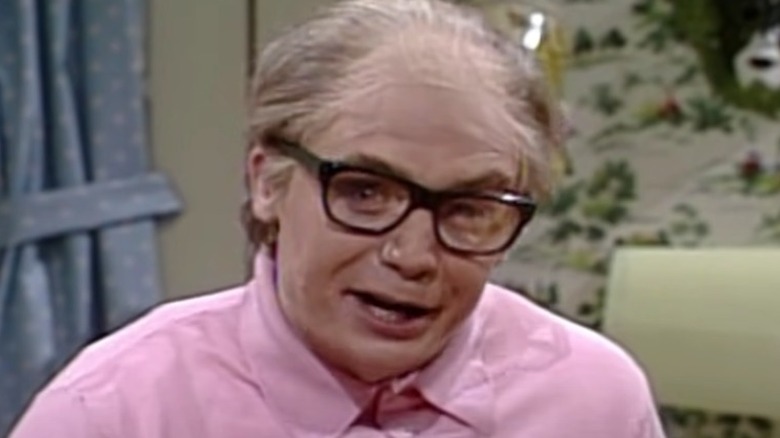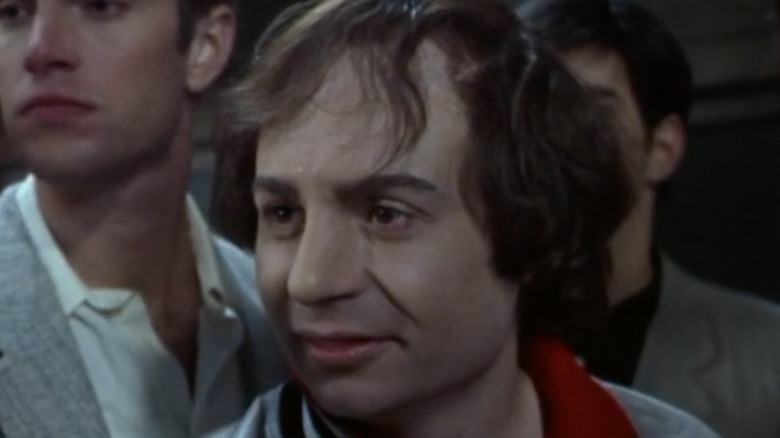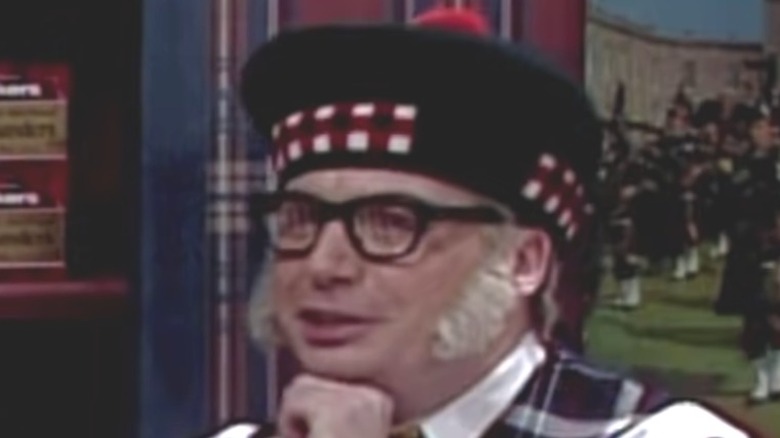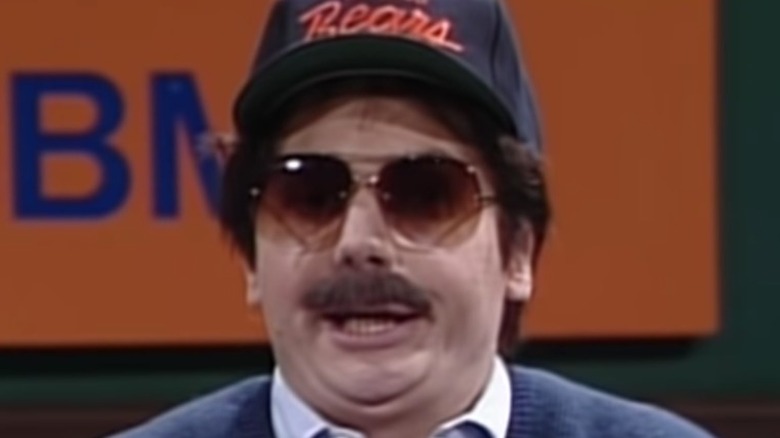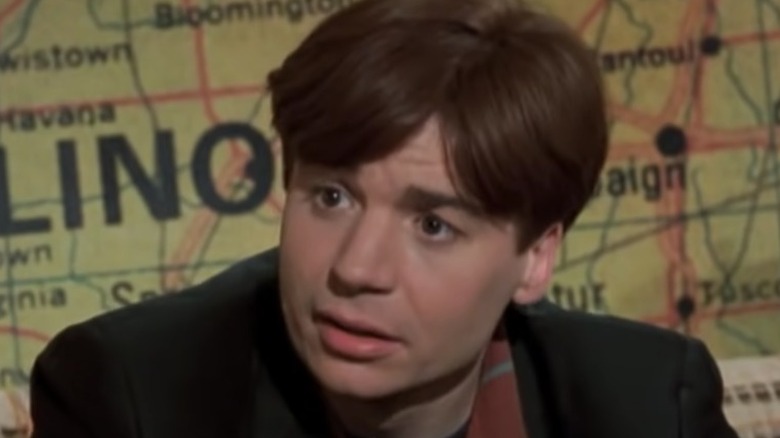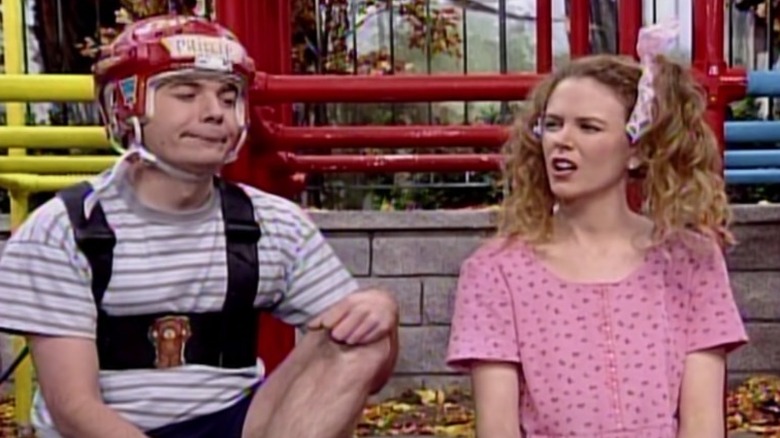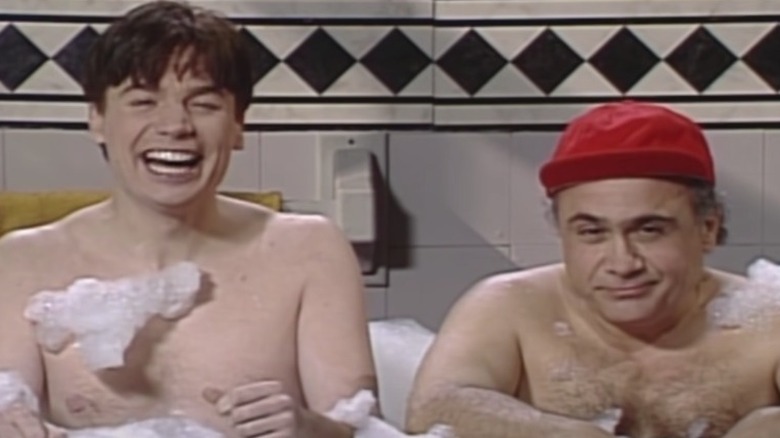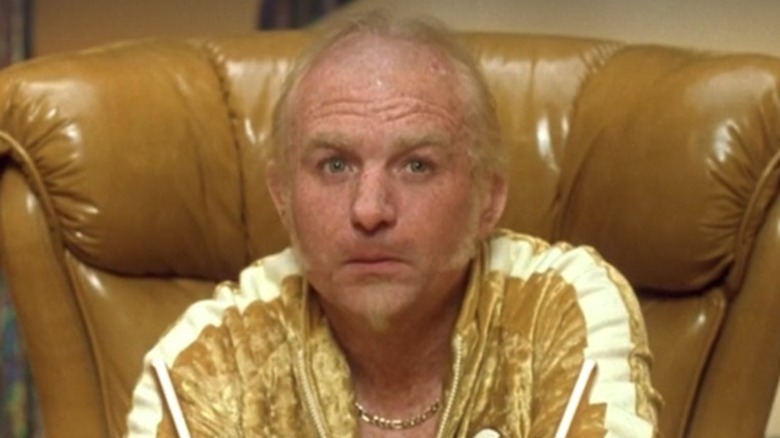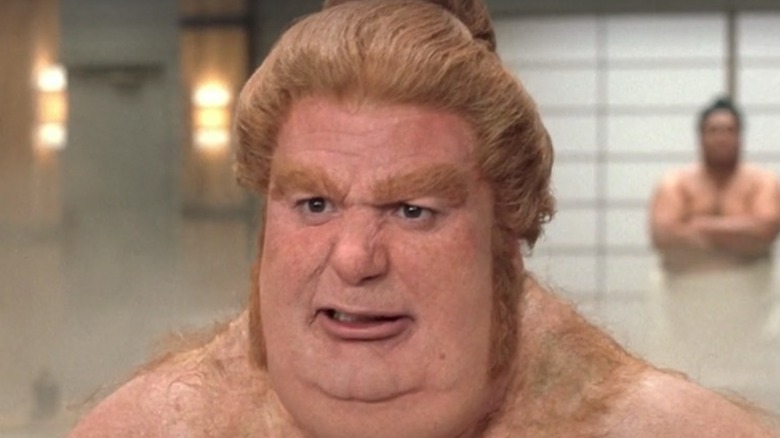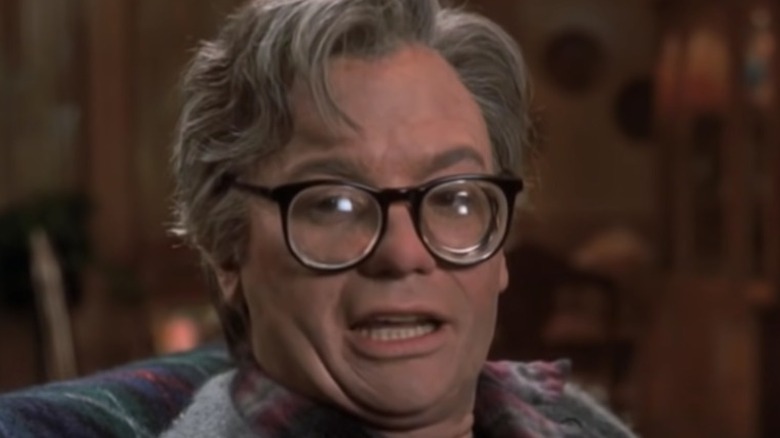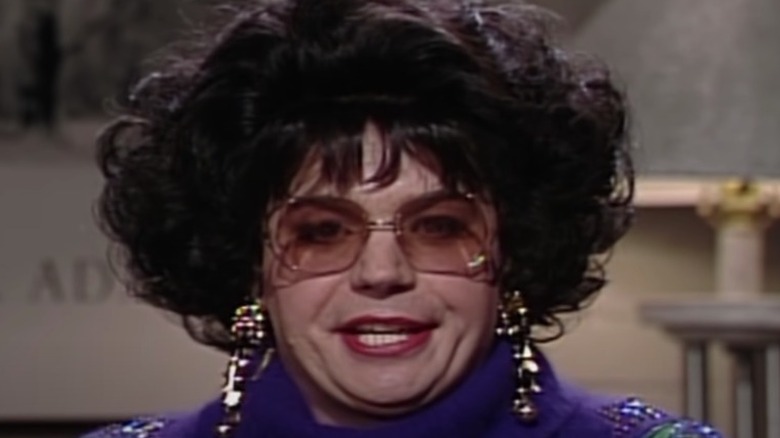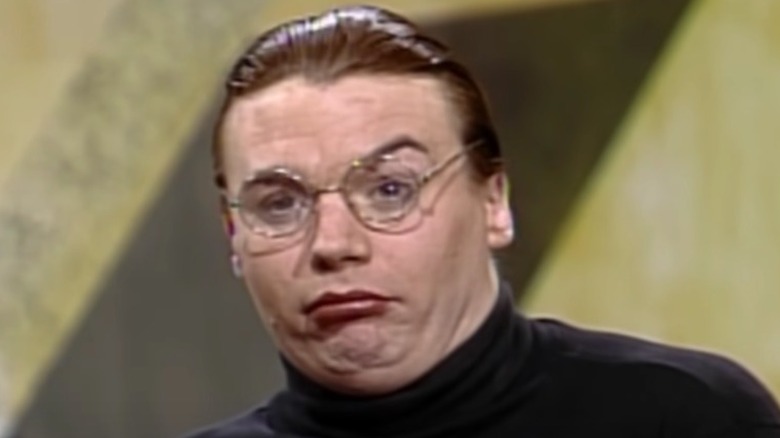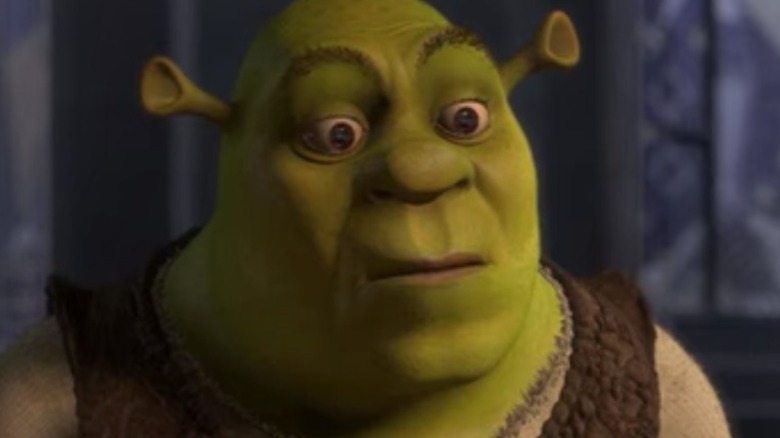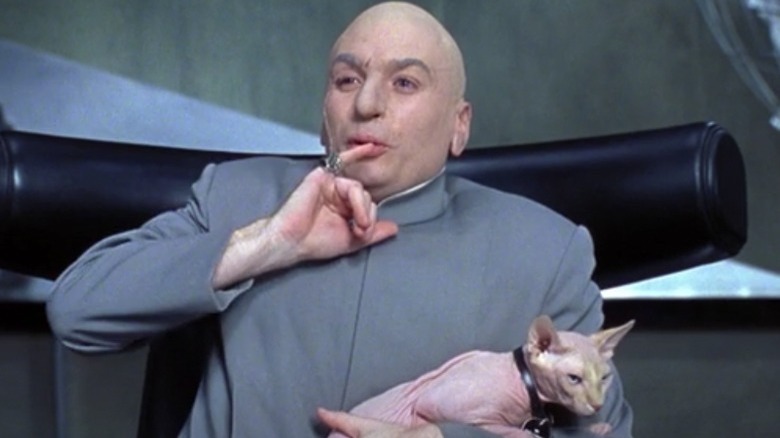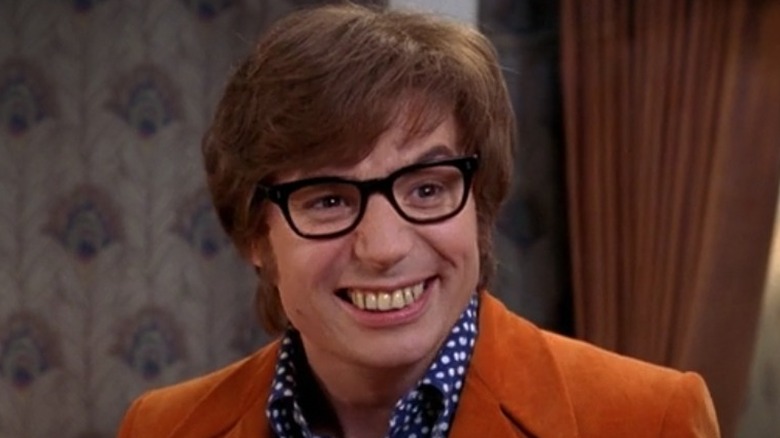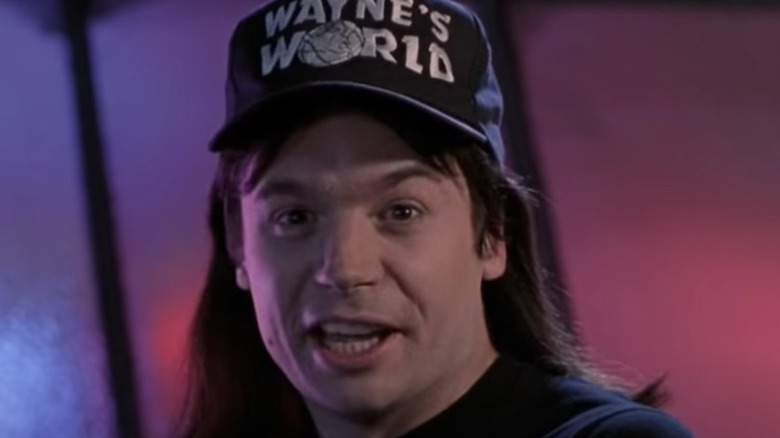30 Greatest Mike Myers Characters Ranked From Worst To Best
One of the most talented and beloved comedians of his generation, Mike Myers has earned fans all over the world with hit franchises like the "Wayne's World," "Austin Powers," and "Shrek" films. Now, more than 30 years after he first broke out on "Saturday Night Live," the Canadian funnyman is looking to simultaneously take a step into a new career stage with multiple characters and pay tribute to a few old ones via "The Pentaverate," a Netflix series that plays off an old joke from "So I Married an Axe Murderer."
From his start as a child actor in Toronto, to honing his youthful comedic chops at The Second City, to breaking out with characters like Wayne Campbell, Myers has parlayed his prodigious talents into writing, producing, and directing a broad range of film and TV projects. Sure, between blockbuster successes, he's also been responsible for some bona fide stinkers ("The Love Guru"), but comedy is rarely safe and sometimes you have to be willing to fall on your face in order to soar.
The core of Myers' appeal has always been his distinctive characters, and the way he disappears in their accents, makeup and mannerisms much like his well-documented comedy hero, Peter Sellers. With this in mind, let's take a look at his most memorable characters of all time, ranked.
30. Maurice Pitka (The Love Guru)
A role so bad that it almost ruined Myers' Hollywood career, Maurice Pitka from 2008's "The Love Guru" ranks as one of Myers' worst creations. In the film, Pitka dreams of becoming the number one guru in the world (besting the world's leading guru, self-help icon Deepak Chopra) and appearing on the "The Oprah Winfrey Show." His spiritual aspirations belie his true lothario nature, so uncontrollable that his own teachers ordered him to take a vow of chastity until he learns to love himself. To self-actualize (and appear on "Oprah"), he must also help the Toronto Maple Leafs win the Stanley Cup.
Myers' comedic prowess, so cleverly honed in other characters, falls flat with Pitka. With enough toilet humor to fill all the portable outhouses at Coachella, "The Love Guru" never elevates beyond crude adolescent comedy, and Pitka is the film's main offender.
"What is it with Mike Myers and penis jokes?" Roger Ebert asked in his review. "He supplements this subject with countless other awful moments involving defecation and the deafening passing of gas. Oh, and elephant sex."
Myers' depiction of Pitka was not only funny, but also offensive to some. He was accused by Hindu leaders of lampooning their faith, with some even asking for a ban on the film. The performance of Myers was deemed "unfunny" and the movie "downright anti-funny" by the New York Times. While it may not have "killed" the career of Mike Myers, the cold reception for the "Love Guru" certainly seemed to make him retreat from the spotlight, as "The Pentaverate" marks the first film or TV show he has toplined in the 14 years since its release.
29. The Cat In The Hat (The Cat in the Hat)
An almost unrecognizable Myers starred as the frantic feline in this uninspired live-action take on the Dr. Seuss book.
Telling the tale of two suburban siblings (Dakota Johnson and Spence Breslin) whose lives are turned upside-down, Myers was the center of the chaos, along with Things 1 and 2, of course. Although colorful and lively, the film took too many creative liberties with its source material, stretching a simple kids' tale about a boring rainy day into elaborate subplots about a scheming boyfriend (Alec Baldwin) and other side alleys not worth exploring.
Myers, his visage hidden behind elaborate prosthetic makeup, injected his Cat in the Hat with manic energy and a Brooklyn accent to rival Bugs Bunny's. Zany, loud, and slightly crude, the character's delightful irreverence was at times impressively lifted from the book page, even if it was too often better than the film itself.
Unfortunately, Myers earned a reputation for bad behavior on the set, driven by what seems to have been a reluctance to be around the other actors when cameras weren't rolling. "It was just a horrible, nightmarish experience. I don't think he got to know anybody. He'd just be with his people and walk away," co-star Amy Hill, who played Mrs. Kwan, told the A/V Club in 2016. "There was a guy who held his chocolates in a little Tupperware. Whenever he needed chocolate, he'd come running over and give him a chocolate. That's what divas are like, I guess. Or people who need therapy."
Perhaps such behavior could be attributed to the epic path of abandoned projects and lawsuits that essentially forced Myers to make "The Cat in the Hat" as a lawsuit settlement. To paraphrase Seuss: the movie was all wet and the sun was not sunny, so moviegoers did not have fun with a movie that wasn't funny.
28. Mr. Franklyn/Clinton Sharp (Terminal)
A role deemed "embarrassing" by Vulture, Myers took on the role of Mr. Franklyn/Clinton Sharp in "Terminal" — no, not the Tom Hanks/Steven Spielberg film, but instead a quickly-forgotten one starring Margot Robbie and Simon Pegg.
Mr. Franklyn is an employer of contract killers, who disguises himself as a janitor to monitor his employees' various activities. Behind the latex façade of his mild-mannered janitor persona lies a cold-blooded puppeteer of violence, closely observing his hitmen via monitors in his lair. It turns out that, unbeknownst to him, Mr. Franklyn has a past he will soon have to atone for, with those close to him administering justice.
There's nothing funny about Mr. Franklyn; he's simply a ruthless villain. Which might sound fun, to see Myers play against type. But like "54" and "Inglorious Basterds," it comes across as more of a gimmick than a chance to exercise any sort of substantial gift as a thespian.
Ultimately, his performance was thrilling for all the wrong reasons. "Myers is at least going for something — even if his character feels like an East End of Fat Bastard," Entertainment Weekly said in its review. "He plays a portly, bucktoothed janitor with a limp under pounds of latex and putty."
"First-time director Vaughn Stein is so inept that the movie is not so much directed as hallucinated," added the Observer. "It is, frankly, unwatchable."
27. Andy Grey (SNL)
The "SNL" character Andy Gray was an early excuse for Myers to bust out his Scottish accent for a few chuckles — and as we've come to learn in the years since, Myers finds few comedy realms more ripe for the picking than riffing off haggis and bagpipes.
Host of the fictional "Scottish Soccer Hooligan Weekly" late night TV show on ESPN 2, Gray and co-host Ian Daglers (Mark McKinney) pound back beers as they riff on the week in Scottish sports. Drunkenly boasting of past soccer glories, Andy bloviates about The Beautiful Game before blowing chunks across the hosting table.
The joke here, of course, is that hooligans are boorish, violent, and loudmouthed. But this is far from Myers' most memorable Scottish material, and its brash, out-of-date humor feels more cringe-inducing today than endearing. Ultimately, Andy and his "Scottish Soccer Hooligan Weekly" crassness get a yellow card for lazy humor.
26. John Witney (View From the Top)
In 2003, Gwyneth Paltrow's star was rising fast, and this comedy about flight attendants offered not only a chance to hear her sing karaoke with Huey Lewis, but also featured Myers as a cross-eyed flight attendant, training her and Christina Applegate in the ways of the friendly skies.
Kitted out in a teal blue uniform, Myers' character takes his ragtag group of future flight attendants through rigorous training, including how to deal with unruly passengers. This dedication to the students hides his own frustrated flying dreams, grounded by his unfortunate visual impairment.
Although Myers has some funny moments, his John Witney isn't so much a character as a person with a physical abnormality that serves as the butt of some jokes. While Witney lines his desk with photos of him posing with ocularly-challenged celebs like Peter Falk and Sammy Davis Jr. in an effort to boost his self-esteem, his bitterness about being grounded bubbles up regularly.
"View From The Top" has its moments, but as one of Paltrow's few straightforward comedies, the New York Times called it "so toothless and scatterbrained that it doesn't really deserve to be called a satire."
25. Paul Baldwin (SNL)
Before Linda Richman became the hostess with the mostess on the recurring "SNL" sketch "Coffee Talk," unamused New Yorker Paul Baldwin held court, talking all things "no big whoop." Myers' Baldwin and ex-girlfriend Audrey (Delta Burke) would just talk — about coffee, drinking coffee, reviewing new coffeemakers. Paul and Audrey would delve into all things caffeinated. Who knew coffee was such a hot topic?
Played with a dry Big Apple attitude, Myers leaned into Paul's New York accent, with much of the humor coming from the regionalisms. Paul and Audrey discussed "coffee, New York, daughters, dogs" and other things with a strong "aw" sound (including Darryl Strawberry), as spoken like a middle-aged man from one of the five boroughs. Baldwin's stint as "Coffee Talk" host was ultimately short-lived, his blasé demeanor too drab for a show about such a peppy substance. Myers was onto something with Paul Baldwin, but the character would eventually become overshadowed by its successor, the similar-in-concept but better-in-practice "verklempt" Linda Richman.
24. Donnie Shulzhoffer (Mystery, Alaska)
Like any good Canadian, Myers is a huge hockey fan (specifically the Toronto Maple Leafs), so much so that a great hockey game has been known to move him to tears. From Wayne Campbell sporting a Chicago Blackhawks jersey while playing a pickup game of street hockey to the "The Love Guru" movie plot centering around the NHL, Myers has frequently integrated his fandom into his career. It's no surprise, then, that Myers leapt at a cameo opportunity in the hockey-centric 1999 film "Mystery, Alaska."
In the flick, Myers plays a television personality named Donnie Shulzhoffer, a take on brash Canadian hockey commentator Don Cherry. Although his appearance in the Russell Crowe/Hank Azaria-starring Jay Roach film (co-written by David E. Kelly) is brief, it's a cute Easter egg for fans of Myers or hockey. Even if one line is perhaps better remembered than all the rest.
23. Ray Foster (Bohemian Rhapsody)
Looking more than a bit like the "Mahna Mahna" guy from the Muppets (it had to be intentional, right?), Mike Myers went incognito in a brief cameo in "Bohemian Rhapsody," one of the biggest films of 2018. It was a nice call-back, as well, since Myers' battle to put the titular Queen song in a now-classic "Wayne's World" scene revived the group for a whole new generation and made the song an unexpected early-'90s comeback hit.
Cast as Ray Foster, a fictional record executive hesitant to release Queen's rock opera masterpiece as a single, he laments that the song is too long and obtuse for radio airplay. The track, according to Ray, is full of nonsense words. Of course, the viewer knows that time will disagree, as "Bohemian Rhapsody" became such a monumental track that it made the Billboard Hot 100 charts in three different decades — at least once with help from Myers.
You wouldn't know it was Myers at first glance, as he's hidden beneath a curly hairpiece and tinted aviator sunglasses that also make him look like the head of the Jeff Lynne fan club but the character, loosely based on EMI music executive Roy Featherstone (via E! News). Ray Foster is fine enough, but as Myers characters go, he's about as memorable as he is recognizable.
22. Ernie Hitchens (SNL)
Perhaps the only predilection Myers clings to more tightly than his Scottish accent is playing old British gentlemen. Fans got an early glimpse of this with Hitchens, a 1990/1991 character he debuted on "Saturday Night Live" in a pair of sketches.
In his debut sketch (alongside Dennis Quaid), Ernie was introduced as a widower with free time on his hands, who had decided to take a massage class at the New Horizons Learning Annex. Decked out in a tweed jacket and thick black glasses, Ernie was game for learning about the "art of MASS-age." In the other skit (with Sting), Ernie gave his critique of a bleak poem read by the former Police singer in character. Praising the poem for capturing the desolate nature of northern England, Hitchens nonetheless thought it needs a bit of cheering up.
Clearly, Myers loves British accents like Vin Diesel loves the word "family," and this character gave him an opportunity for plentiful regional wordplay. However, simply being a middle-aged British stereotype doesn't make for a compelling or memorable character, so Ernie has been lost to time — although, hints of the character can be glimpsed in other Myers Brits, including perhaps Austin Powers.
21. Lank Thompson (SNL)
Actor Lank Thompson was an early Mike Myers character who is handsome and he knows it. Thompson is the developer of the "Handsome" series of courses, a technique that promises to elevate ho-hum dudes into hot gentlemen in no time. With his volumized coiffure and freshly-pressed tuxedo, Thompson promises that his techniques will unleash your hidden handsomeness. Graduates of his courses include such noted dashing men as Robert Wagner, Billy Dee Williams, and David Hasselhoff. Thompson brings handsomeness to the masses via infomercial, and his handsome course can be yours — all for the low, low price of $39.95. Just don't ask him about Gerard Depardieu.
Thompson made three appearances on "Saturday Night Live" between 1989 and 1992; perhaps the most memorable of these sketches had him introducing Alec Baldwin, a self-professed handsome actor who had graduated from Lank's program and demonstrated such leading man moves as the dramatic removal of eyeglasses and signing paperwork without looking down.
The Thompson character riffs on masculine stereotypes, parodying manly tropes pervasive in mid-to-late 20th century pop culture stars like Charlton Heston or Kirk Douglas. Although it's fun to watch someone like Baldwin lampoon himself, many of the jokes fall flat without context — and on the other side of the satire, while there are plenty of present-day charlatans still trying to cash in on your low self-esteem, the specificity of the character can be lost on those who didn't make "Hart to Hart" appointment TV watching.
20. Lothar of the Hill People (SNL)
Lothar of the Hill People has seen a lot and he's done a lot, so he's tired all the time. This Myers character takes on the heavy responsibilities of being a leader, and decompresses by connecting with other chieftains. Lothar of the Hill People can manage a harvest, yet he and his comrades can't deal with the women in their lives, as Lothar exclaims: "Women: You cannot walk with them, and yet you cannot club them." Lothar and his mates are perplexed by female power, and so they lament their confusion by comparing their woes.
Myers based Lothar of the Hill People's voice on the one he used while playing the board game Dungeons & Dragons (via New York Times). The character is also a light riff on "take my wife ... please" jokes by comedians like Henry Youngman and Rodney Dangerfield. But watching these four sketches from 1990/1991 today, it underscores how much times have changed; a sketch whose aim was to traffic in such dated Borscht-belt concepts as harried men and their overbearing women wouldn't get beyond the pitch process these days. By making Lothar of the Hill People's ignorance about gender equality the joke, it helps make the character work a bit, but nonetheless, Lothar is still best left in a time capsule.
19. Kenneth Reese-Evans (SNL)
In another of Myers' over-the-top "SNL" skits he played Kenneth Reese-Evan — known in the British theater as "Cucumber Jones" and host of "Theatre Stories," an actors' panel discussion about triumphs on the stage.
Over four appearances between 1991 and 1994, Reese-Evans and his guests would reminisce about their thespian lives, each performer sharing ever-escalating stories of their sexual escapades, backstage blunders, and other salacious gossip. Myers would pull his chin way in to make it look like he had multiple, pausing his voice for dramatic emphasis as the comedian and his guests (John Malkovich, Phil Hartman doing his great Charlton Heston) would channel the spirits of notorious British thespians/hard-partiers like Oliver Reed, Peter O'Toole and Richard Harris.
Speaking with a labored cadence, Reese-Evans has endured decades on the stage, his wild gestures clearly meant to communicate to the back of the auditorium. Sporting a tweet jacket, bushy eyebrows, and some serious mutton-chop sideburns, Reese-Evans is planted firmly in the past and bewildered by the present.
Kenneth Reese-Evans is another elderly British eccentric in the Myers stable, albeit perhaps the only one who seems like he's suffering from hernia pain — still, it's hard not to laugh when he begins recounting stories of his adult film work alongside a young John Gielgud and Dame Judi Dench.
18. Mick Jagger (SNL)
One of the great things about "SNL" is that Lorne Michaels has always seemed able to get legends like Paul McCartney, Paul Simon or Mick Jagger to show up anytime he gives them a call, making for many memorable moments over the years. Perhaps second only to Chris Farley interviewing Sir Paul was Myers doing a "Start Me Up"-era Jagger alongside the Rolling Stones frontman, continuing a fun "SNL' tradition that goes all the way back to the dueling Joe Cockers.
With pursed lips and a strategic hand on his hip, Myers hilariously captured Jagger's swagger as Mick himself played as Keith Richards. Sprinkle in copious usage of words like "bloody" and "man," and Myers nailed the essence of the rock icon while ostensibly commenting on the hot-button issue of the day involving Ice-T's "Cop Killer" song with his band Body Count.
As with Myers' penchant for all things British, he has clearly done a lifetime of homework. The "Weekend Update" segment is remembered today as a "Saturday Night Live" classic moment, fueled by a celebrity impression elevated by its performers' charm and the good humor of the legend seated to his left.
17. General Ed Fenech (Inglorious Basterds)
As far as out-of-left-field characters in Quentin Tarantino movies are concerned, few can compete with Myers making a cameo appearance in this 2009 WWII film, playing a British military official who briefs Michael Fassbender's character on Operation Kino — a mission to kill Hilter, Goebbels, and other high-ranking Nazi officials at movie gala premiere in Paris. Although Tarantino almost certainly didn't mean it this way, the character plays like a passing of the torch to Myers from Michael York's Basil Exposition, who would delightfully set up the film's plot and then back away in Myers' "Austin Powers" movies.
Standing in a room alongside Winston Churchill, Myers' relatively-dialed-down Fenech explains to the uniquely-suited British soldier (he has a background as a film critic and is well-versed in German cinema) that the movie gala puts all the "rotten eggs in one basket" — a basket he then intends to blow up.
Myers does a good job tempering his typically-wacky British impression to portray the fastidious British military officer. Dressed in an officer's uniform and sipping "whiskey straight — no junk in it," General Fenech calmly explains the strategic details of Operation Kino with precision and aplomb, doing justice to Tarantino's always-compelling dialogue. Myers' Fenech is a fine, understated performance in a film filled with histrionic violence. He only appears in only the one scene, but it's a heckuva scene.
16. Ed Miles: Middle-Aged Man (SNL)
Possibly the first "SNL" recurring character on this list that became a full-on cultural touchstone, long before viral videos and social media you could tell which Saturday skits hit hardest when everybody was repeating the catchphrases on Monday at school or the office. And for a brief while, Middle-Aged Man jokes were all the rage. In the early half of the '90s, the aggrieved line "What are you lookin' at? You're lookin' at my gut, aren't ya? Well, I'm workin' on it!" would bring an easy smile to the faces of like-minded comedy fans.
In three key appearances during Myers' breakout "SNL" seasons of 1990/1991, he depicted Ed Miles, a superheroic "Middle-Aged Man" who would swoop in when needed — halted only by the occasional Maalox moment. Sporting a pink polo and sensible slacks, Ed solved problems as only men ages 40–55 could. He also had a great theme song.
Dashing to wherever he's needed, with the occasional stop to catch his breath and rest his back, Middle-Aged Man arrives with a cheerful "Maybe I can help?" Accompanied beautifully by sidekick Drinkin' Buddy (Chris Farley), Middle-Aged Man would dish out wisdom about car batteries and marital infidelity. Like many heroes, Middle-Aged Man was burdened by a weakness, with insecurities about his gut often getting the best of him. He might not always be sexually desirable, but this was a character who always knew where his appliance warranties were located.
Middle-Aged Man took the banal, Dockers-wearing dude next door and elevated his quirks into superpowers. Playing up the crotchetiness, hunched over with poor posture, his padded paunch resting tightly on his belt, this Myers character might be his most underrated "SNL" creation. We got movies out of Pat and The Ladies' Man, so why didn't we get a full-length Myers/Farley film about the adventures of Middle-Aged Man and Drinkin' Buddy?
15. Steve Rubell (54)
Mike Myers' first shot at a full-on dramatic role was in the 1998 drama "54," about the short-lived yet infinitely influential New York City disco hotspot. Cast as nightclub co-founder Steve Rubell, whose entrepreneurial zeal to make the world's greatest party palace let him with money troubles from the IRS, the comedian's sincere work was a standout in an otherwise ill-received film.
Myers' Rubell knows what his clients want, but struggles with coming to terms with what he himself truly desires. As Rubell, a noted personality with a distinctive aura, Myers never veered into caricature; the "SNL" funnyman captured a sincere sadness behind Rubell's successful business façade, and at the time it looked like it could be a launching pad for a dramatic side career along the lines of contemporaries like Jim Carrey.
Unfortunately, "54," a gritty film with LGBTQ themes, suffered under massive reedits at the behest of Miramax Studios, becoming "sanitized nearly beyond recognition" (via Vulture). Miramax's cut of the film was a commercial and critical flop upon its release, and Myers' understated dramatic performance as Rubell, like the film itself, got lost in the shuffle. If you are a Mike Myers super fan, it's worth seeking out.
14. Stuart Rankin (SNL)
Another breakout "SNL" recurring character, if you say the name Stuart Rankin to someone they won't know who you're talking about — but if it's someone who came of age in the '90's and you instead scream: "If it's not Scottish, it's crap!" an ear-to-ear smile is sure to follow.
Fully embracing the Scottish accent that would serve him so well years later as Shrek, Myers went full-tilt with Rankin, a man who lives and breathes his Highland heritage and is, among other things, proprietor of All Things Scottish. He may or may not be wearing underwear beneath his kilt, the door to his store opens to the sound of bagpipes, and he doesn't take kindly to those who mock his accent and Scots ancestry. Oh, and don't you dare ask him if he has any Irish stuff for sale.
Quick to burst into a rage, Stuart is just as willing to break out the fisticuffs as he is to embrace in a hug.
Stuart Rankin went through an evolution of sorts, first appearing on "Weekend Update" as a Scottish reporter offering his fiery commentary on, well, all things Scottish. When "SNL" revisited Rankin, Myers evolved the character to be older and more cantankerous, all while sporting a balmoral bonnet. Laying the groundwork for Myers' other notable Scottish characters, Stuart Rankin could hardly be considered a crap character.
13. Pat Arnold (SNL)
Another Myers character that became a catch-phrasing, fan-loving, recurring breakout (albeit, one that was more of a team effort), Myers shined as
Pat Arnold, one of "Bill Swerski's Superfans," a sketch lampooning late '80s/early '90s Chicagoland sports fandom and their reverence for encased meats, beer and of course, Mike Ditka.
Myers, who spent much time in Chicago performing with The Second City theater troupe, clearly was having a lot of fun over five sketches, his character part of a radio show celebrating "Da Bears" and "Da Bulls" while chugging beer, gorging on fried food and taking the occasional break for a heart attack. Tried and true fans, Arnold and the Superfans were anything but fair-weather.
Hiding behind a walrus mustache, tinted aviator sunglasses and a Chicago Bears sweater vest, Myers perfectly captured the endearing arrogance of a region still reveling in its 1986 Super Bowl victory, filled with endless opinions and zero personal athleticism. It became a fun recurring sketch because it would always bring back "Cheers" star George Wendt and easily made space for folks like Tom Arnold, John Goodman and more (including cameos from the likes of Dick Butkus and Michael Jordan) to join in on the fun.
"Bill Swerski's Superfans" has become one of the most enduring "SNL" sketches in the show's history, finding life through the decades not only on "SNL," but in Chicago sports celebrations and commercials for everything from football to insurance.
12. Charlie MacKenzie (So I Married An Axe Murderer)
Considered by many to be among the most underrated comedies of the early '90s, "So I Married an Axe Murderer" certainly didn't make a lot of money at the box office. But funny, endlessly-quotable lines, a great soundtrack and Myers as multiple characters made this a staple of the VHS-rental era.
Myers stars in the film as Charlie MacKenzie, a San Francisco poet unlucky in love. With support from his best friend Tony (Anthony LaPaglia) and Scottish parents Stuart (Mike Myers) and May (Brenda Fricker), Charlie eventually finds love with Harriet (Nancy Travis), who may or may not be an axe-wielding serial killer. Who ever said love was easy?
A mild-mannered protagonist, the character of Charlie isn't anything special, per se — he's the Zeppo in a film that surrounds him with enough zany characters to bring a manic, Marx Brothers-like insanity to his life — but the rare opportunity to see Myers as a romantic leading man gives "So I Married an Axe Murderer" a narrative construct well worth your time. Ultimately his father, Stuart — Myers' other, far showier, role — is the one you'll remember, but the film wouldn't hold up without Charlie.
11. Phillip the Hyper Hypo (SNL)
A 1993/1994 recurring sketch, "Phillip the Hyper Hypo" had Myers playing a child who is both hyperactive and hypoglycemic. Tethered to playground equipment by his mother via a harness, Phillip seeks out friendship with other children, played by the likes of Nicole Kidman and Kim Basinger.
Clad in a helmet (a move that even little Phillip understands is a little overprotective), Phillip and friends would converse in ways that only 6-year-old children could, zigging and zagging the conversation through a gamut of emotions in minutes.
Myers breathlessly channeled non-sequitur, rambunctious child energy with ease in the sketches, much like he did with his "Simon" appearances. There was never anything malicious about Myers' performance of Phillip; it was endearing and appropriately innocent. Just a kid who wants to play with other kids, Phillip's inquisitive nature and unfiltered opinions went a long way in capturing the innocence and vulnerability of making random childhood friends on the playground.
10. Simon (SNL)
Based loosely on "Simon in the Land of Chalk Drawings," a British animated series made in the '70s, these "SNL' sketches felt a bit like companion pieces for the aforementioned Phillip — even if Myers' Simon, always in his bathtub, was far more of a cheeky monkey.
Well you know his name is Simon, and he likes to do "drawerings," and Myers would hop into bubble baths to play the precocious host of a BBC series while showing off child-like etchings that would weave together tales slightly more heartbreaking than Simon could comprehend. The ever-perky Simon would bring special guests onto his show, sharing his bathtub with other kids including American Vinny (Danny DeVito) and cowboy Trevor (Macaulay Culkin).
If Austin Powers was a kid, he'd be Simon. He's not into girls, but he's charming and ever so slightly naughty. Armed with an adorable British accent and bubbly naivete, Simon might just be Myers' cutest character. Unknowingly surrounded by dysfunctional adults, Simon cheerfully splashes about the bathtub and is happy to share his artwork with viewers. Just be sure to not look at his bum!
9. Goldmember (Austin Powers in Goldmember)
One of four characters that Myers portrayed in the third film of the Austin Powers franchise, the Dutch supervillain was a roller-disco owning, gold-obsessed henchman of Dr. Evil (also Myers), as well as a loose parody of Gert Frobe's Auric Goldfinger in the 1964 James Bond flick that bore his last name.
Goldmember "loooves" gold so much that he lost his genitals in an unfortunate smelting accident, hence his name. He has since not only developed tractor beam technology to destroy the Earth, but also kidnapped Austin Powers' estranged father Nigel (Michael Caine), kicking off the movie's time traveling adventures.
Myers was inspired to create Goldmember after watching the HBO series "Real Sex," wanting to create a character that would out-libido Austin Powers (via USA Today). Goldmember is a worthy adversary for Austin, equal parts dangerous and bafflingly sensual. However, is it sexy to put your skin flakes in a box for safe keeping? That, perhaps, is best left in the eyes of the beholder.
8. Fat Bastard (Austin Powers movies)
Fat Bastard was Myers' deliciously disgusting, "dead sexy" Austin Powers villain who debuted to much fanfare in 1999's "Austin Powers: The Spy Who Shagged Me" and would later return for 2002's "Austin Powers in Goldmember."
A gargantuan, sweaty, red-headed Scotsman with an insatiable appetite for food and sex, Myers layered on the prosthetic makeup to play this blundering baddie. In "The Spy Who Shagged Me," Fat Bastard stole Austin's mojo, and in "Goldmember" he revealed a new career as a sumo wrestler.
If Bastard had a superpower, it was his endless ability to eat. He became convinced that Dr. Evil's pint-sized sidekick Mini-Me (Verne Troyer) would make a great snack, memorably yelling for him to "get in my belly!" Fat Bastard later revealed a surprising sensitivity about his weight, saying "I eat because I'm unhappy, I'm unhappy because I eat."
Enamored with the smell of his own farts and impressed by his excrement, Fat Bastard gave Myers plentiful opportunities for toilet humor. And while his potty talk might not be for everyone, there's no denying that Fat Bastard's interpretation of the Chili's "Baby-back ribs" jingle became downright iconic. With his glistening rotund physique and absurdly foul mouth, Fat Bastard might be one of Myers' most bizarre, yet most memorable character creations.
7. Stuart MacKenzie (So I Married an Axe Murderer)
While Charlie MacKenzie was the lead role in the 1993 comedy "So I Married an Axe Murderer," Myers' work as Charlie's father Stuart stole the show.
Perhaps the ultimate incarnation of Myers' "Scottish Man" character, Stuart is the pride of his home country. With a "Scottish Hall of Fame" enshrined on his walls and an unironic love of Scottish pop music stars Bay City Rollers, Stuart may live in San Francisco, but his heart clearly remains on the moors of Scotland. Stuart loves a good conspiracy theory, including that of "The Pentaverate," a secret society made up of the five wealthiest people in the world who control everything and the eventual subject of Myers' Netflix series.
Decades after the film's release, Stuart remains one of Myers' most beloved characters. Will Stuart make a cameo in "The Pentaverate"? If so, it would likely have to be engineered by people as powerful as the Gettys, the Rothschilds and Colonel Sanders (before he went tets-up).
6. Linda Richman (SNL)
She might not have been the original host of the "SNL" sketch "Coffee Talk," but Linda Richman certainly became the most memorable.
A Barbra Streisand superfan who never met a bedazzled sweater she didn't love, Richman's liberal sprinklings of Yiddish phrases and frequent entreaties are as memorable as her requests to "talk amongst yourselves" when she would get "verklempt." Like much of Myers' best "SNL" work, all these phrases and mannerisms made their way firmly into the '90s zeitgeist.
Richman's "Coffee Talk" was a must-stop destination for folks who wanted to chat "coffee, New York, daughters, dogs. You know, no big whoop." Over 15 appearances from 1991 to 1997, Richman hosted not only the likes of Bill Murray and John Travolta, but also had a memorable encounter with Madonna, Roseanne Barr and her beloved Barbra that became a "like buttah" cultural moment.
What you might not know is that Linda Richman was a very personal character for Myers. Based on his former mother-in-law, who had stints as worked as, among other things, a motivational speaker, the real-life Linda Richman grappled with tragedies and afflictions like agoraphobia for much of her life, publishing a 1998 book "I'd Rather Laugh: How to Be Happy Even When Life Has Other Plans for You" that told the story behind the laughs.
Richman quickly became one of Myers' most recognizable characters, with an immediately identifiable look and quotable catch-phrases. The character even made a crossover into real life, appearing on stage at Barbra Streisand's series of comeback concerts in 1993 and 1994 (via New York Times). When an entertainment legend lets you crash her stage, you know you've achieved icon status.
5. Dieter (SNL)
Now it is zee time on "Sprockets" where vee ... well, remember "Sprockets."
"Would you like to touch my monkey?" wasn't really a euphemism (okay, maybe it was), but rather the most frequently-asked question on this off-kilter skewering of West German talk shows. Disaffected "Sprockets" host Dieter would interview various art-world celebrities to get their hot takes on the day's cultural trends. Minimally decked out in a black turtleneck, black tight pants, and round wire glasses, Dieter's looks relayed that he wasn't impressed with much — but that didn't mean he wouldn't break out into dance at any given moment.
A couple decades before Steve Jobs became the world's most famous wearer of black turtlenecks, Dieter made his debut on The Second City stage (via The Second City), later becoming a character Myers would take with him to "Saturday Night Live." Dieter became so popular that Myers developed a film around him — one that was ultimately abandoned over the "artistic integrity" of the project, leading to him being sued for breach of contract (via The Guardian). That a Dieter movie never materialized is all the more tragic because reports say the script was one of Myers' funniest creations (via Vulture). But do not despair — you can always get your "little girl" happiness via old clips on the internet.
4. Shrek (the Shrek movies)
Mike Myers' animated green ogre Shrek became a delight for comedy fans of all ages. A surly giant with a pronounced Scottish brogue and serious bodily gas issues, Shrek just wants to be left alone in his swamp, but peaceful solitude is interrupted by a group of banished fairy tale creatures with nowhere else to go. His quest for quiet kicks off his adventures, leading Shrek to inadvertently find the friendship and love that's been missing from his life.
2001's "Shrek" was a smash at the box office, grossing almost $500 million at the globally (via Box Office Mojo). Its success spawned a massive entertainment franchise, including three movie sequels, a spin-off movie, numerous television specials, a stage musical, and theme park attractions. The sheer ubiquity of Shrek makes him one of Myers' best characters, and although their early-'00s CGI aesthetic have dated them a bit, the Myers-less 2022 film "Piss in Boots 2: The Last Wish" kept the story moving along while serving as a reminder that the "Shrek" films retain huge brand recognition.
3. Dr. Evil (the Austin Powers movies)
The villainous mastermind of the "Austin Powers" film franchise, Dr. Evil will stop at nothing to achieve total world domination. With a voice inspired by "SNL" executive producer Lorne Michaels — or more accurately, comedian Dana Carvey's Michaels impression — Myers depicted Dr. Evil as a slightly inept yet very dangerous nemesis of Powers (also Mike Myers).
Based loosely on Donald Pleasence's iconic take on James Bond villain Ernst Stavro Blofeld in "You Only Live Twice," Dr. Evil oversees a perfectly legitimate corporation called Virtucon, led by his minion Number Two (Robert Wagner), which fronts his diabolical schemes for global takeover. Cryogenically frozen in the '60s and thawed out in the '90s, Dr. Evil might not understand modern economics, but he sure knows his weaponry. Obtaining and deploying "sharks with frickin' laser beams attached to their heads" is a particular obsession.
With a rich lineup of supporting characters, including his dwarf clone Mini-Me (Verne Troyer), son Scott (Seth Green), and assistant Frau Farbissina (Mindy Sterling), Dr. Evil has all the help he needs to take on Austin Powers, yet he can never get a "frickin' bone" thrown his way. Endlessly quotable and visually iconic, Dr. Evil is surely one of Myers' best characters, as most recently revived for a funny 2022 Super Bowl ad.
2. Austin Powers (the Austin Powers movies)
Swinging his way through London and beyond, Mike Myers' Austin Powers, star of one of the most beloved comedy franchises of the past several decades, is the ultimate gentleman spy. Does he make you horny, baby? Then he's doing his job!
His groovy aesthetic — thick black glasses, crushed blue velvet suit, and crooked teeth that enforce the gnarliest of British dental stereotypes — is so popular that the look is still referenced in popular culture decades after "Austin Powers: International Man of Mystery" introduced the character, a Myers riff on everything from "Modesty Blaise" and "Flint" films to James Bond and "Hammerhead."
Austin Powers is always randy, but don't let his penchant for sexy times fool you. Powers always comes through with his superspy skills, always thwarting his nemesis Dr. Evil in the nick of time.
Myers has gone on record saying that Austin Powers is a tribute to his late father, a native Liverpudlian and fan of British spy thrillers. Parodying characters like James Bond, Harry Palmer, and Jason King, Austin Powers is a loving tribute to the day-glo days of swinging London and all-things groovy.
1. Wayne Campbell (the Wayne's World movies)
One word can best describe Mike Myers' character Wayne Campbell: "Excellent!" From his humble beginnings on the Canadian comedy TV series "It's Only Rock and Roll," to "Saturday Night Live," to two movies and some commercials in between, Campbell has been everyone's favorite good-time hard rocker for decades. If it's Friday and it's 10:30 p.m., it means it's time to party with Wayne and his friend Garth Algar (Dana Carvey) on their cable access show "Wayne's World." Campbell and Garth riff on things like their love of movies, Aerosmith, and Claudia Schiffer. Their show definitely doesn't suck.
Wayne and Garth have always been endlessly quotable and thoroughly charming, and their first film is a downright classic (topping the box office for five consecutive weeks, it remains the highest-grossing film based on "SNL" characters). Driving their flame-embossed Gremlin through Aurora, Illinois while rocking out to Queen's "Bohemian Rhapsody," Campbell is always on the prowl for a rockin' good time — and remains the greatest Mike Myers character of all-time. Party on, Wayne!
